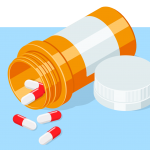Sanofi on digital therapeutics — and how it helps patients

When the World Health Organization (WHO) looked into factors that determined an individual’s overall health, they found that 20 percent is associated with medical care and between 20 to 30 percent is linked to behaviors such as diet, exercise, lifestyle, positive thinking, and so on.
Digital therapeutics — the use of an app to guide a user’s everyday food and lifestyle choices —helps better align behavior with medical care. As a result, it increases the sphere of influence of medical professionals looking to accelerate recovery among patients.
(For the curious, the WHO study said that the remaining 50 percent was determined by the individual’s environmental, social, genetic, and psychological make-up.)
Speaking with McKinsey Partner Ivan Ostojic, Sanofi Global Head of Digital Therapeutics Bozidar Jovicevic said the potential of the technology is actually compounded by the timing of it.
“If we look at major trends, people are living longer, on average, so there’s a rise in chronic diseases associated with aging. Meanwhile, healthcare workers are in short supply, and physicians and nurses don’t have enough time for patients.
“Yet everyone has powerful computers in their pockets that give them access to technology, education, and information. Put all that together, and it’s the perfect moment for digital solutions to come to the market, change behavior, and enhance health outcomes at scale.”
Focusing on digital therapeutics makes absolute sense
According to Sanofi, more than 80 percent of healthcare spending in the US (US$3.4 trillion) alone is related to diseases that could be modified or even reversed through behavioral change.
“So yes, the world does need digital therapeutics.”
Jovicevic says that the company is keen to focus on capturing the opportunity that digital therapeutics provides.
“We look at this in different ways. One is to focus on diseases or therapeutic categories where a change in behavior can have a huge impact—neural diseases, cardiovascular diseases, diabetes, and others.
“Another angle is to look at any disease that costs healthcare systems a lot of money, affects large numbers of patients, and can be significantly affected by digital therapeutics. So identifying diseases where we can move the needle is the first step.”
As a pharmaceutical company with more than US$35 billion in revenues and a new CEO (Paul Hudson) focused on optimizing the business’ transformation agenda for growth and innovation, Sanofi is keen to make the most of the opportunity.
For now, there are questions that Jovicevic believes don’t have answers. Questions about the role and responsibility of medical professionals when digital therapeutics become commonplace, the business model for healthcare institutions as well as pharmaceutical companies offering robust digital solutions, and so on.
“There are many variables,” Jovicevic told McKinsey’s Ostojic. “But everything starts with finding the therapeutic categories where we can really influence outcomes.”
A glimpse into the long-term future of healthcare
Healthcare facilities the US’ Mayo Clinic and the UK’ National Health Service (NHS) have been experimenting with chatbots for a while and are exploring the feasibility of telemedicine solutions in the near future.
Digital therapeutics, then, isn’t a far-fetched idea and Sanofi is clearly setting itself up for success by making the right investments in the concept right now.
“The long-term picture is much more important, but it’s intangible and abstract. Digital therapeutics present a big opportunity. They have the potential to become a multibillion-dollar category.
“The greatest value will be from data. If we know, for instance, when the right time is for a patient to move to the next step in the treatment algorithm, that will be better for everyone in the system.”
According to Jovicevic, the world needs digital therapeutics because it can drive behavior change at scale.
The Sanofi executive points towards the behavioral change that social apps and mobile games currently drive and hopes that the world will leverage smartphones to help create a healthier, happier future for everyone.
“[…] ten years from now, I’d love to see prescribing and using digital therapeutics become just standards of care—a normal thing, like prescribing a drug. That would reshape the practice of medicine,” concluded Sanofi’s Jovicevic.










